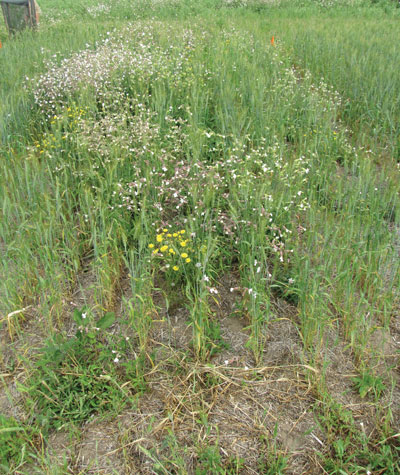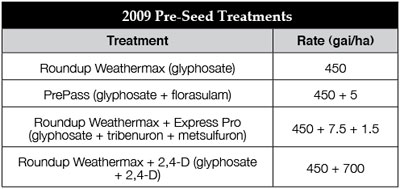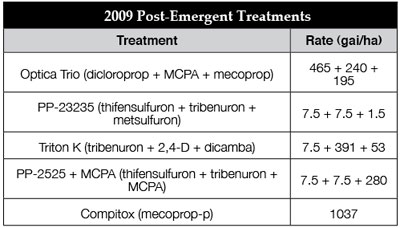
Features
Desiccants
Seed & Chemical
White cockle control possible in spring wheat
White cockle may not be the worst weed on the Prairies, but where it exists, it can cause growers frustration. As an annual, biennial or short-lived perennial, white cockle can be difficult to control. “White cockle typically evolves into a perennial, and with a deep taproot, it can be difficult to control,” explains research assistant Ken Sapsford at the University of Saskatchewan. “It produces a lot of seeds, so there are usually a lot of annual seedlings around, as well as the perennial plants.”
March 18, 2010 By Top Crop Manager
White cockle may not be the worst weed on the Prairies, but where it exists, it can cause growers frustration. As an annual, biennial or short-lived perennial, white cockle can be difficult to control. “White cockle typically evolves into a perennial, and with a deep taproot, it can be difficult to control,” explains research assistant Ken Sapsford at the University of Saskatchewan. “It produces a lot of seeds, so there are usually a lot of annual seedlings around, as well as the perennial plants.”

|
| Without herbicides, white cockle can cause crop competition. (Photos courtesy of Ken Sapsford) |
In order to determine the best approach for white cockle control in spring wheat, Sapsford set up a trial in 2008 at two western Canadian sites: northeast of Edmonton, Alberta, and northeast of Prince Albert, Saskatchewan. Three trials were established at each site, which included a pre-seed burnoff treatment; post-emergent in-crop treatment; and a pre- and post-harvest treatment. “The 2008 trials were set up to eliminate the products that didn’t provide adequate control. From those trials, we took the best herbicides to see which treatment system worked the best,” says Sapsford.
In 2009, Sapsford took the approach that a sequential treatment would be necessary to control the perennial white cockle plants. He first applied four pre-seed treatments: glyphosate, PrePass, a Roundup Weathermax /Express Pro tank-mix and a glyphosate/2,4-D tank-mix.

|
In the preseed burndown, none of the herbicide(s) controlled white cockle adequately, with percent control less than 80 percent in all cases. However, Sapsford says that all the herbicides controlled the white cockle annuals very well; the perennials were the biotypes that escaped full control. “That told us that one shot wouldn’t do it. There needs to be combinations of herbicides applied at different times to fully control white cockle,” says Sapsford. “There was some difference in the pre-seed burndown between herbicides, but control still wasn’t good enough.”
Good control achieved with sequential in-crop application,
but with some puzzling differences
For the sequential post-emergent treatments, Sapsford selected five different herbicides to try out: Optica Trio, PP-23235, Triton K, PP-2525+MPCA tank-mix, and Compitox.

|
Herbicides containing the Group 2 active ingredients, PP-23235, Triton K and PP-2525+MCPA products, provided more than 80 percent control of white cockle at both sites in 2009, regardless of which pre-seed burndown was used.
The post-emergent Group 4 product Compitox and Optica Trio provided 80 percent control at the Prince Albert site but were not much better than the no-post-emergent treatments at the Edmonton site. “We aren’t sure why the Group 4 products didn’t perform as well at Edmonton. We are following up in the greenhouse to see if there is a species difference between the sites,” says Sapsford.
The PP herbicide products are the Precision Pac mixes from DuPont. Sapsford cautions that when using Precision Pak products, that the grower needs to ensure that they do not go over the recommended application rates for sequential products. Express Pro followed by PP-23235 means that active ingredients tribenuron and metsulfuron are being applied at both the pre-seed and post-emergent stage.
Pat Forsyth, field biologist for Alberta, with DuPont Canada, says that an Express Pro sequentially followed by PP-23235 would fall outside of the current label of either product. The labels for both products state that only one application of metsulfuron methyl can be made at 1.5 grams active ingredient per hectare (gai/ha) in order to use the recropping labels that apply for each product. “If sequential application were made with these products, the recropping restrictions would no longer be valid as the total amount of metsulfuron methyl applied to the treated area in one season would be 3 gai/ha. This would change the recropping recommendation for subsequent seasons.” explains Forsyth.
Another puzzling result was that PrePass provided similar pre-seed control as Express Pro, but the post-emergent sequential treatments following PrePass did not provide any better control than the untreated control. “PrePass may be providing such good control at the pre-seed stage that the weed was weakened to the point that it wasn’t taking in the post-emergent herbicide so there weren’t any significant differences in control,” explains Sapsford. “I’m not sure what the recommendation should be if you are using PrePass. It gave the best pre-seed control, but the post-emergent control with other herbicides wasn’t as good. We’ll have to try to sort that out as well.”
In the meantime, Sapsford says the best approach for white cockle control is to take a two-stage approach, using a pre-seed burndown followed by an in-crop treatment using any of the products shown in the treatment charts. That approach should provide commercially acceptable control, and help growers get on top of white cockle problems.